Portable Power Centers How To Choose
Portable Power Centers, also called portable power stations (PPS), have recently become very popular. When coupled with solar panels for charging they are called solar generators.
The manufacturers and models available to choose from seems almost limitless. Just type in Portable Power Centers into Amazon’s search bar and you will instantly be presented with hundreds of choices.
I studied and compared makes and models for weeks, and only three manufacturers made the cut. The three shown below have the best technology, greatest efficiency, longest-lasting batteries, and biggest bang for your buck.
The picture above shows an Anker PowerHouse “Solar Generator” Solix F2000 with included solar panels. The waterproof solar panels will charge the Anker Solix F2000 in just 3.8 hours (under ideal sun conditions). You can add up to four solar panels for even faster charging. This powerhouse will run my residential refrigerator for 10.5 hours during a power failure. It also has a 30 amp RV outlet so I could plug in my motor home during camping season.
What is a Portable Power Center?
A Portable Power Center is actually just a big battery with a built-in charger, a nice sine-wave inverter (changes the 12 volt DC battery power to 110 volt AC power), and a plethora of output plugs to connect to. The portable power centers mentioned below also have state-of-the-art battery cooling systems and fast response BMS (Battery Monitoring System).
Most portable power centers can be charged by plugging them in to an AC outlet at home, the cigarette lighter in a car, solar panels, or a gas generator. The EcoFlow model shown below can also be charged by an EV charging station.
Unlike a gas generator, a portable power center provides smooth, clean power without the noise or exhaust fumes of a gas generator.
Why Do You Need a Portable Power Center?
- Do you need to be on the Internet while you’re camping? Does your phone go dead really fast when creating a hot spot?
- While camping, do you need to run a CPAP machine all night?
- Do you live off-grid? Will you be coupling this with a solar system?
- Do you want to be able to run your refrigerator for several hours when there’s a power outage?
- Do you want to run your entire RV for a weekend of boondocking?
- Maybe you’ll want to run your RV’s air-conditioner all night.
- Will a portable power center run my RV’s household refrigerator while traveling all day?
Things to consider when choosing a portable power center
Let’s take a look at some criteria for choosing a portable power center that would be right for you. I installed an ANKER, Solix, F2000 in my RV.The shore power plugs right in to it. It powers my refrigerator when I’m driving, keeps the RV battery charged, and also charges my phone and tooth brush.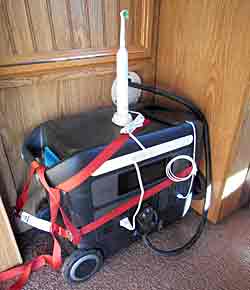
The battery
Check the battery type. Some portable power center manufacturers are still using lead/acid car batteries that were invented in the mid-1800’s. Battery technology has greatly advanced since then, mostly in the last 30 years. Most portable power centers are made with a version of lithium ion-battery. There are several variations of the lithium-ion battery. You want a LiFePO4 lithium iron phosphate (LFP). Check the number of charge cycles in the manufacturer’s specifications. A standard lithium-ion battery will only have about 500 charge/discharge cycles. An LFP battery will last for 3,000 cycles. EcoFlow has their battery up to 6500 cycles.
For more detailed information here is a page on the Anker website that spells out the details. Here’s even more details from WikipediA.
The BMS (Battery Monitoring System)
One of the keys to longevity of the battery is the battery management system. The temperature of a lithium-ion battery should be between 32°F and 120°F. The BMS monitors the temperature and shuts the portable power center off if either limit is reached. A LFP battery is not the type that explodes or bursts into flames. But a robust cooling system can greatly increase efficiency and longevity of the battery. The BMS controls that.
The inputs and outputs
Every portable power center offers 110 volt AC outlets. Many also have a 12 volt DC output like you’d find in your car. Most also boast a number of USB outlets. This is where you need to be careful. Older portable power centers may only have the “A” or “B” USB outlet. There is now a USB “C” version being used. Make sure these USB outlets are compatible with your devices.
I get excited when I see an outlet matching my 30-amp RV plug. That opens up a huge area of usage for my lifestyle. See my YouTube® video showing me testing the ANKER, Solix (formerly the 767) in my RV.
Charging Speed
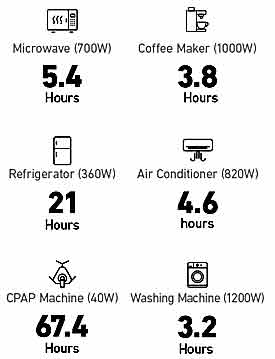
Check the speed of the charge time in the specification section of the power station’s web page. Portable power stations using Gallium Nitride chips offer the fastest charge times. One type of GN chip, Abbreviated GanPrime, monitors the battery and component temperature so precisely they can shave an hour of the typical charge time increasing efficiency.
How big should your portable power center be?
How large the capacity that your portable power station needs to be depends on what you need to run. Most portable power center websites will list the amount of time you could expect their device to run certain appliances (shown on the right). They take into account things like efficiency and average power use.
Renogy has a page taking a deep dive on the math involved so you can calculate the times yourself.
Efficiency
Most portable power stations are 85% efficient. The Anker 767 (now called the Solix F2000) is 95% efficient. Figuring that in gives me the idea that it might run my refrigerator for 21 hours.
Buying a Portable Power Center That’s Too Small
Most often the mistake I see people making is buying a portable power station that is too small. The price was great but they run out of power fast and scramble for ways to recharge it. 1000 watts and below are useless. Get a whopper like a 2000 or 3000 watt portable power center. It might cost a bit more but you’ll be happy you spent the money every time you use it.
Portable Power Center Contenders
Out of the hundreds of portable power centers available here are my favorites:
Anker’s claim to fame is ultra-efficient and fast chargers.
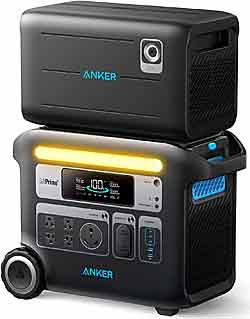
Their line includes a host of product chargers, as well as five portable power centers of which the 767 shown above is the largest. Their products boast the fastest charge times and longest warranty.
The Anker Solix F2000 is rated a 2048 Wh. The 2400 watts of AC output offered by the 767 happens to equal the exact amount of power fed from a typical 20-amp AC circuit in a house.
You can control all aspects of the ANKER, Solix F2000 on your phone using their intuitive app.
Instead of the average 2 years, Anker, Solix F2000 Portable Power Station is designed to reliably power your devices every day for 10 years. Additionally, it offers a superior 5-year full-device warranty for a guaranteed, worry-free experience. They use LiFePO4 batteries. Lightweight and long-lasting.
Shown here with the expansion battery bundle for a whopping 4096 Wh and the Anker App Smart Control for $1,899.00.*
Watch my video testing my ANKER 767 (now called the Solix F2000) in my RV for the first the time. When my on-board battery was exhausted the ANKER 767 ran everything including the microwave oven and charging the battery.
Here’s my follow-up YouTube video® where I installed it in my RV.
The ANKER C2000 Upgrade
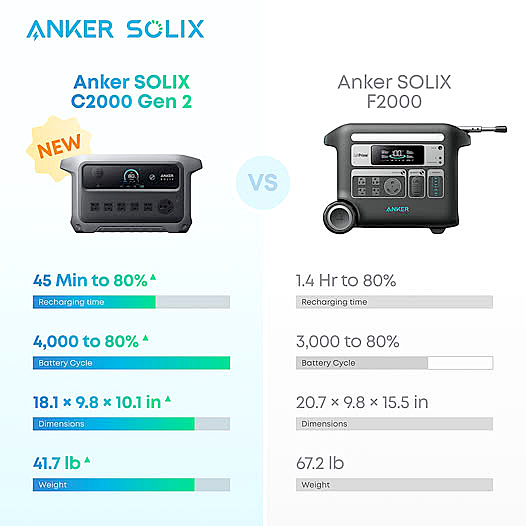
ANKER is coming out with a new version of the F2000 called the C2000. See the comparison in this image:
It’s small, lighter, charges faster, with the same capacity as the F2000. It’s amazing what just one year of technological advancement can make.
The C2000 will be available by the end of 2025 and you can pre-order it for just $749.00* until October 27. After that it will still be sale priced, but $799.00* until November 3. Then it goes up to it’s regular price of $1,499.00.
If you are looking at these other manufactures always look for the latest technology. Many of them are still selling older product so shop and compare.
Jackery

Jackery has been the leading seller of portable power stations for many years. Lately, however, they have been playing catch up. The Jackery 2000 PRO is their answer to the ANKER 767.
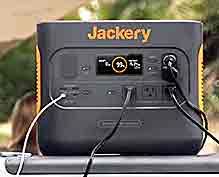
“Jackery Explorer 2000 Plus, Portable Power Station, powers up to 8 devices at a time with a battery capacity of 2160Wh and an output power of 2200W. Explorer 2000 Pro satisfies all your demands for electricity during camping and power outages. The optimum choice due to its outstanding features, including quick charging in 2 hours via AC input, all-round safety with industry-leading BMS, and advanced smart screen.”
When viewing the features and specs at a glance, it would appear that their specs are better than the ANKER. However, drilling down into the details, we realized that the specs and features aren’t quite as good, and it’s a bit more expensive. But like all of these devices, there’s always a sale price or special offer that brings the price down. That being said, Jackery makes great products and has good customer service.
Download this .pdf, Jackery vs ANKER , for an exact comparison. Use coupon code 2000PLUS for a Special Offer-Jackery Solar Generator 2000 Pro+ 200W*2
Add the coupon code: JADEAL to your purchase at checkout for an additional 10% off and free shipping.
EcoFlow is the leader in large home-backup power systems.
They have a constellation of products that hit most price points and uses. Their power kits greatly simplify connections. They use an LFP battery, an improved version of the LiFePO4, that is less toxic to the environment, safer to operate, and will last up to 10 years (6500 charges).
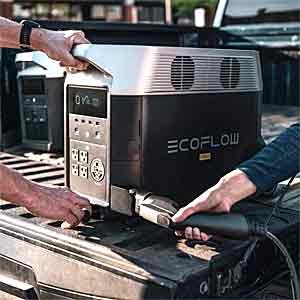
The Delta Pro can deliver 3.6k Wh and be expanded up to 25k Wh. The cost is $3,699.00*
Use coupon code ECOFLOWAFF for 5% off all products.
Charge the Delta Pro from an Electric Vehicle charging station
Not only can the EcoFlow be charged by solar panels, plugging into an AC outlet, and your vehicle, the Delta-Pro can also be charged by an EV charging station in just 1.7 hours. With two EcoFlow Delta Pros and the EcoFlow Double Voltage Hub you can also charge your EV!
EcoFlow also has a portable air-conditioner and smart generator that work flawlessly with their portable power centers and control seamlessly with their app.
Their smart generator auto-starts when your DELTA Pro hits a low level of charge, re-charges your DELTA Pro, and stops the engine all by itself once your DELTA Pro hits a full charge.
The warranty on the Delta Pro can be up to 5 years. You might also be eligible for a 30% tax credit if connected to your home as a whole house backup system.
The Bluetti AC200L is another contender that should be considered. It has the LiFePO4 Battery with 3,500+ Life Cycles to 80%.
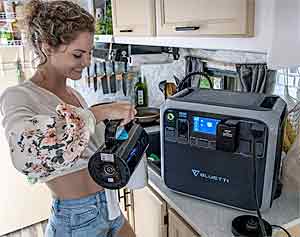
The 2048 Wh capacity can be increased to 8,192 Wh with two B300 expansion batteries.
Each of the 12 output ports is kept clean by a dust cover. It has the RV 30-amp outlet too. The USB A and C ports with the pure sine wave inverter makes it perfect for electronics.
In addition, there are two magnetic charging plates on the top. Just set your devices on the top and they charge. No wires. It’s perfect for your iPhone, iWatch, and AirPods.
You can actually be charging the Bluetti AC200L with two sources at once. Plug in to an AC outlet and add solar panels to charge in about 2.5 hours.
Bluetti claims claims 3500+ charges to 80%. It weighs 61.9 lbs. but does not have wheels. There are 4 x 120V/20A Outlets, and 1 x 120V/30A NEMA TT-30 for a total output power of 2200W.
The Bluetti AC200L is $1,799.00* with 4 year warranty.
More pages of the Tiny Life Consulting website you’ll be interested in:
Off-grid living in a Tiny House
Generators or Portable Power Centers: Which One is Right for You?
Portable Inverter Generator Comparison


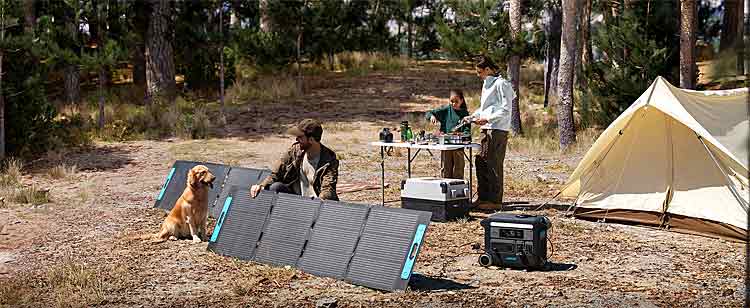








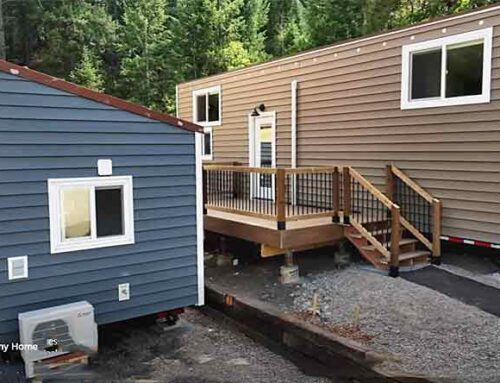
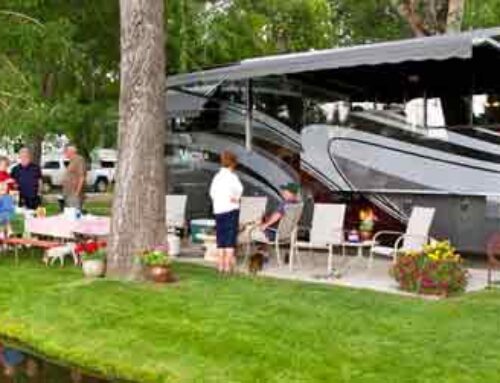

Thank you for the great information